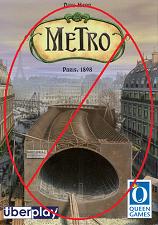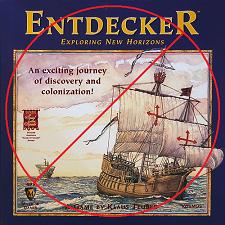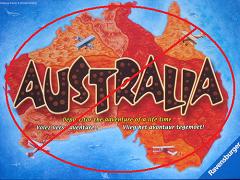

|
Metro, Entdecker, Australia... What do these three things have in common? If this were a game of Tribond, this would be the only question that I could actually get right. Have you figured it out yet? The answer’s not that I traded away all three games because I’ve only traded away two of them, yet. If you guessed that all three of these games limit a person’s color selection based on the number of players in the game then you are correct. As is probably clear from the title, this is a big pet peeve of mine. This has been the subject of repeated GeekLists on BoardGameGeek, cropping up every couple months, in which users attempt to list all of the games that share this more-annoying-than-it-ought-to-be trait. I’ve been meaning to write about my disdain, no... contempt, no... hatred, yes that’s it, of this phenomenon for a while now, but finally got the motivation after reading a recent thread on BoardGameGeek asking people what color they prefer to play. I realized that most gamers have a strong preference for what color they play; at least most gamers who are passionate enough to read and post on BoardGameGeek (ignoring the response bias that inevitably accompanies such an informal poll). As a minor aside, I was stunned at the number of people who always play yellow when it’s available for the exact same reason I do (i.e., we think it’s generally unpopular and therefore no one else will want it), how odd! However, I digress, back to the object of my loathing: games that limit a person’s color selection based on the number of players in the game.

|
For those of you who have no idea what I’m talking about (you lead a charmed life), allow me to explain the problem in slightly more detail. Metro was the first game I discovered which implemented this technique. The game plays with two to six players, and comes with pieces in a wide array of colors, including black, blue, green, orange, purple, and yellow. The game comes with “subway cars” (used to indicate which stations belong to each player) in each of these six colors. Like many games, the setup conditions vary depending on the number of people playing. With only two players, each person controls 16 stations, whereas each person controls only 10 stations in a three-player game, all the way down to controlling a mere 5 stations in a six-player game (why anyone would play this game with six players is beyond my comprehension). So far so good (except for the actual gameplay, but that’s another story), but the problem begins to take shape when you realize that Queen Games (the dastardly publisher in this story of woe) only included 16 “subway cars” in blue and yellow (at least they chose the right color). If you want to play Metro as a two-player game then one person must be blue and the other person must be yellow. Why you ask? “I have no clue” is the only reasonable answer. I can’t imagine that this cuts costs by any appreciable amount, but that’s the only rational reason I can think of, so it must allow the publisher to save some money. To finish off the story, there are only 10 orange bits included, 8 green ones, 6 purple ones, and a measly 5 black pieces. For all those people who love playing purple but so rarely find the chance (when not vying for control of China), and are excited to see purple included when opening this game, you better be able to find four friends because you won’t be playing purple in Metro unless you’re in a five-player game. A wag of my finger (courtesy of Mr. Colbert) to Queen Games and Dirk Henn (the masterful designer of Wallenstein), who should never have let his game be defaced in this manner (even if it does pale in comparison to reenacting the Thirty Year’s War). The game claims to be for 8 year olds and up, but they had to go and crush the hopes and dreams of all the only children out there who desperately wanted to play green in a three-player game with their parents. It’s a traveshamockery I tell you! |
|
This wouldn’t be a problem worth writing about (it’s probably not one anyway) if it were confined merely to the game of Metro, but it’s not, instead it’s a veritable epidemic of “board game bit shortage.” The second game I happened across containing this seemingly insurmountable flaw was Entdecker. Klaus Teuber had never led me astray before, but I suppose there’s a first time for everything. Mr. Teuber and Mayfair not only fell into the Metro-trap, but left yellow on the outside looking in; a double whammy! Entdecker requires 20 scouts for a 2-player game, but only includes 20 red and white scouts. For a 3-player game only 15 scouts are needed, which is how many yellow ones are included, and purple obviously gets the least love as only 12 purple scouts are included, which is the bare minimum needed for participating in a 4-player game. You better not lose one of those purple scouts because this certainly isn’t a Days of Wonder production. The scouts are even smaller wooden bits than the “subway cars” in Metro, so the excuse of saving costs and the rainforests is greatly diminished. I want my missing 5 yellow scouts and 8 purple scouts, and I want them now. How am I supposed to have the most guys on those jungle paths with those unnecessarily fancy contraptions for hiding the goods if I spot my opponent a handful of scouts from the beginning? |

|

|
Finally, there’s the ugly stepchild of Wolfgang Kramer and Michael Kiesling’s action-point series: Australia. This Ravensburger game had a lot to live up to after winning Game of Year from Games Magazine and when coming on the heels of such masterpieces as Java and Torres from only a few years earlier. Boy did it fall flat, but not just because it furthered the phenomenon of conserving bits to deprive players of full color selection. Australia has your team of rangers simultaneously involved in numerous industrialization and conservation projects to erect power lines across the continent and save all the koalas from getting tangled in those same power lines. It’s a game of mixed messages, except for one clear message: you don’t get to choose your color. You need 20 rangers in a 2-player game, but only black and white have enough rangers for such a duel. You only need 14 rangers in a 3-player game, and instead of giving you 20 orange rangers, you get a mere 14 for your 30 bucks. There are only 11 blue rangers, which is just enough for a 4-player game, and a measly 10 brownish tan rangers for those oh-so-rare 5-player games. Kramer, Kiesling, and Ravensburger all certainly deserve a double wag of my finger for not only failing to include yellow bits altogether, but also falling victim to one of the classic blunders. No, the trio didn’t get involved in a land war in Asia, but they did join the woeful trio of Metro and Entdecker upon publishing this koala letdown. |
It’s surprising and disturbing that this trend is not limited to one designer or publisher, but rather is running rampant across the board game industry. Publishers as notable as Queen, Mayfair, and Ravensburger are defacing the games of such designing luminaries as Monsieurs Henn, Teuber, Kramer, and Kiesling. These outrages have got to stop, or, or, well, nothing bad will happen whatsoever, but I may be forced to write a follow-up column on this issue, which I know none of you want, since you already want the last 5 minutes of your life back. Maybe that’s the leverage I can use to convince you to write letters to these publishers to plead with them to charge us the extra 50 cents and include all the bits necessary for players to freely choose their color regardless of the number of players. As the title conveyed more succinctly than these past 1,371 words ever could: Let me choose my color!